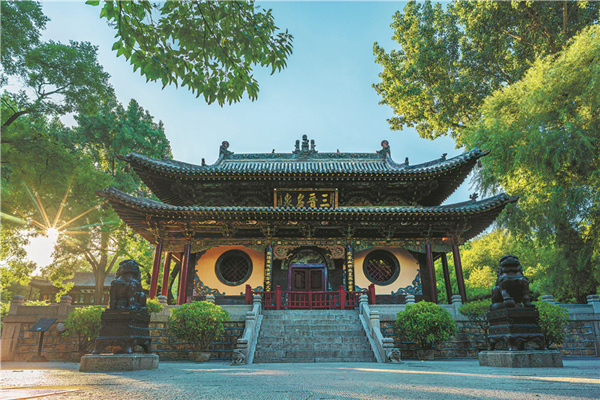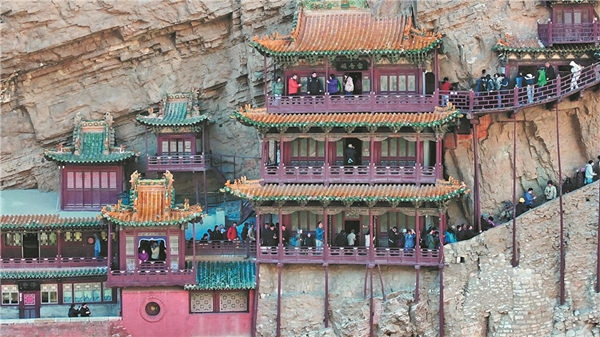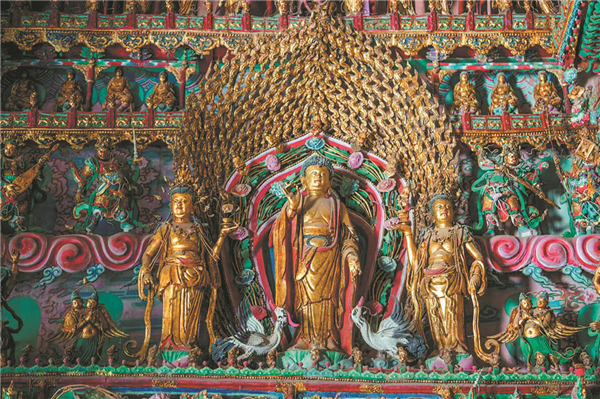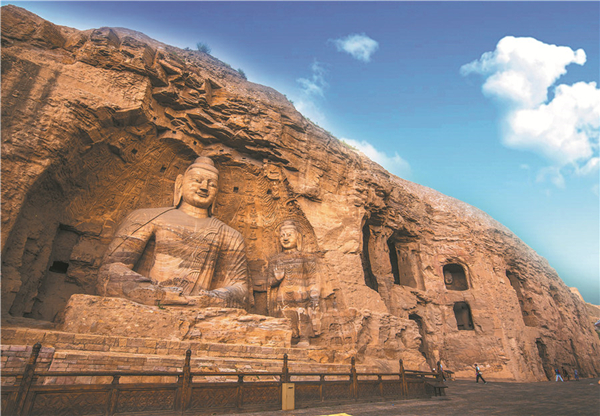Shanxi's wonders inspire art of hit game

Jinci Temple in Taiyuan. It is among Shanxi's attractions featured in Black Myth: Wukong. [Photo by Hao Shengyu/For China Daily]
Success of Black Myth: Wukong spurs sharp rise in tourist visits to province
On Aug 20, the highly anticipated Black Myth: Wukong – A Chinese self-developed AAA game – made its domestic and global debut, immediately becoming a hit in the industry.
Notably, the game has also sparked interest in Chinese culture, as it is deeply rooted in Chinese mythology and inspired by the legends of the Monkey King – or Sun Wukong – in Journey to the West, a Chinese classic novel that has been represented in numerous films, TV shows and cartoons.
Black Myth: Wukong is a followup to or a recreation of the novel. With the game, players control a young monkey who, inspired by the legend, decides to follow Wukong's footsteps to the West, overcoming various difficulties and trials, ultimately achieving success, according to the players' own actions.
Another distinguishing characteristic of the game is that its art design has taken inspiration from ancient Chinese architecture and other traditional cultural elements.
This cultural feature of the game has resulted in additional benefits outside the game industry, arousing fervent enthusiasm from netizens to experience the Chinese cultural heritage displayed in the game. Thus, according to Chinese media reports, it has generated a new touring option – following in the footsteps of Wukong to see the Chinese cultural attractions.
Shanxi is no doubt one of the biggest beneficiaries of this cultural tourism boom as the North China province boasts the largest number of locations where the game takes place.
Of the 36 scenic spots featured in the game, 27 are located in Shanxi, according to Shanxi's cultural and tourism officials.
Shanxi's landmark sites of ancient buildings, like Foguang Temple, Nanchan Temple and Jinge Temple in Xinzhou; Xuankong Temple in Datong; Shuanglin Temple in Jinzhong, Chongfu Temple in Shuozhou; and Yuhuang Temple in Jincheng, are the standout settings of the game.

Xuankong Temple in Hunyuan. It is among Shanxi's attractions featured in Black Myth: Wukong.[Photo by Li Yao/For China Daily]
Officials at the Shanxi Culture and Tourism Department said that Shanxi was selected by the game's development team as the major destination for filming because it boasts some 28,000 sites of ancient buildings – the largest number in China's provincial-level regions. With preserved buildings constructed in a period from Tang (618-907) to Qing (1644-1911) dynasties, Shanxi has the richest varieties and styles of ancient architecture.
Developers at Game Science, the producer of Black Myth: Wukong, have also endorsed Shanxi's unique position in the preservation of ancient Chinese architecture and other cultural assets.
The developers' team, headed up by Yang Qi, art director of the game and cofounder of Game Science, had visited the sites of historical interest in Shanxi many times before the production of the game.
Yang's team began to visit Shanxi's ancient relics sites for preproduction research four years ago. During the visits, he paid special attention to the ancient structures, the statues and wall paintings featuring various Buddhist and Taoist legends in 20-plus locations in Shanxi.
His team used 3D modeling and shot videos for an astonishing number of figures and images of these sites, under the approval of Shanxi's cultural heritage authorities.
"The figures of 10 Yama Rajas (Kings of Hell) in Chongqing Temple in Zhangzi county, the 24 devas (angels) in Tiefo Temple in Gaoping city, the 28 constellations in Yuhuang Temple in Jincheng city, are all the amazing things that I can borrow inspiration from," Yang said in his Weibo account, just naming a few.
The team's extensive and intensive journeys in the province would result in an extravagant show of Shanxi's culture and tourism throughout the game, which was what local cultural and tourism officials expected when they received the team's visits. So they showed strong support to the team.

Xiaoxitian in Xixian. It is among Shanxi's attractions featured in Black Myth: Wukong. [Photo by Feng Siquan/For China Daily]
"When they had their last shooting trip here in July, a deputy head of our county government, who is familiar with local history and culture, offered to become their guide," said an official in charge of the Xiaoxitian – or Small Western Paradise – scenic area in Xixian county.
Shanxi's tourism and cultural heritage authorities also attached great importance to the game production team, requiring local officials to offer assistance.
The cooperation between Shanxi and Game Science has achieved a win-win result. Shanxi's tourism authorities and operators have been authorized to use the game to promote its cultural tourism attractions.
In June, when Game Science began to launch presale promotional campaigns, the Shanxi Culture and Tourism Department also began a series of promotional campaigns featuring the Wukong-related scenic sites.
Following the game's launch, the department released a promotional video entitled Travel Shanxi with Wukong. The video follows in the footsteps of the Monkey King and takes viewers on a virtual tour of renowned attractions, including the Yungang Grottoes and Huayan Temple in Datong; Nanchan Temple in Xinzhou; Yingxian Wooden Pagoda and Xiaoxitian.
Officials at the department also said that social media uploaders are encouraged to create new works for Shanxi's ancient buildings featured in Black Myth: Wukong. Excellent works will be awarded and subsidized by the department.
During the 2024 Digital Culture and Tourism Brand Innovation Conference held in Taiyuan from Aug 22-25, the Travel Shanxi with Wukong campaign was officially launched, introducing three themed tourism routes and an eight-day Shanxi ancient architecture self-driving tour.
These routes connect real-life locations depicted in Black Myth: Wukong, inviting tourists to experience Shanxi through the game's lens.

A huge Buddha statue in Datong's Yungang Grottoes. The figures of both Buddhist and Taoist religions are the source of inspiration for the popular game. [Photo by Hao Shengyu/For China Daily]
Several travel platforms and institutions, including Tongcheng and Ctrip, have launched dedicated packages for these routes. They are cooperating with hotels and scenic spots to offer accommodation, ticket discounts, and cultural and creative gifts to attract more tourists from across the country to Shanxi.
As Black Myth: Wukong becomes a hit domestically and globally, Shanxi has seen an immediate rise in popularity in its tourism industry.
The game is available on multiple online game platforms, including PS5, Steam, Epic Games Store and WeGame.
According to media reports, just minutes after its release at 10 am on Aug 20, the game surged to the top of global app store best-seller lists, maintaining its high visibility until well past 10 pm, when it set a record for concurrent users on Steam.
At 8 pm, 10 hours after its official release, the game realized a global sales volume of 4.5 million copies, garnering 1.5 billion yuan ($210.6 million) in revenue. It sold 10 million copies in the first three days. Goldman Sachs expects the game will rake in 5 billion yuan on Steam.
In Shanxi, scenic sites relating to the game are also seeing a rapidly growing number of tourists, who want to see the real things that have been rendered into their familiar game images.
Over the past two weeks after the game's release, Huayan Temple in Datong, for instance, reported a 50 percent increase in tourist visits compared with the same period of last year, according to local officials.
Yuhuang Temple – also known as Jade Emperor Temple – in Jincheng city is one of the sites gaining increasing popularity thanks to Black Myth: Wukong.
Local officials said that Yuhuang Temple used to be a quiet place as it was a less known destination among tourists.
"Over the past two weeks, we have seen full reservation of tickets thanks to the release of the game," said Yin Zhenxing, an official in charge of the scenic site's operation.
The official said a unique selling point of the temple is the many figures of deities governing the 28 constellations, which are among the sources of inspiration for Black Myth: Wukong.

The colored statue of Kangjinlong – or Soaring Metal Dragon – in Yuhuang Temple in Jincheng. The figures of both Buddhist and Taoist religions are the source of inspiration for the popular game. [Photo by Hao Shengyu/For China Daily]
According to ancient Chinese astrology, the universe is composed of 28 constellations governed by various deities. As the deities are always accompanied by a certain animal, they are named after the animal plus one element out of sun, moon, metal, wood, water, fire and earth. For instance, Kangjinlong – the stereotype of a much loved figure in the game – literally means "Soaring Metal Dragon".
"Figures of 28 constellations are commonly seen in many sites of the Taoist religion," Yin said. "But the ones in Jincheng's Yuhuang Temple have unique historical and aesthetic values."
He explained that all the colored statues of constellation deities there were created by famous Yuan Dynasty (1271-1368) sculptor Liu Yuan. "They are well preserved and feature vivid facial, emotional expressions you can hardly find elsewhere."
The official added that there are many other things with similar historical and cultural values, like the structures built in the Song (960-1279) and Jin (1115-1234) dynasties and wall paintings created since the Song Dynasty.
"Over the past few years, we have devoted much energy to promote the value of the temple among tourists," Yin said. "We are receiving an increasing number of visitors this year – about 50,000 visits to date."
He noted many of the visitors are young people taking part in study tours like fine art students and designers portraying the statues and wall paintings.
The official added that the successful launch of Black Myth: Wukong ignited a drastic increase in visits at the end of last month.
A tourist surnamed Li, who is from Guangzhou, Guangdong province, is among visitors arriving at Yuhuang Temple after the release of the game.
"I'm here to see the 'angry goddess' of Kangjinlong," she said. "To my delight, I've found exactly the same thing in the temple."
Latest media reports predicted that Shanxi will be among the hottest destinations during the coming National Day holiday in early October thanks to the game. On popular online travel platform Qunar, the number of searches of Shanxi soared by 1.2 times in August compared with the previous month.
Hao Hong contributed to this story.



